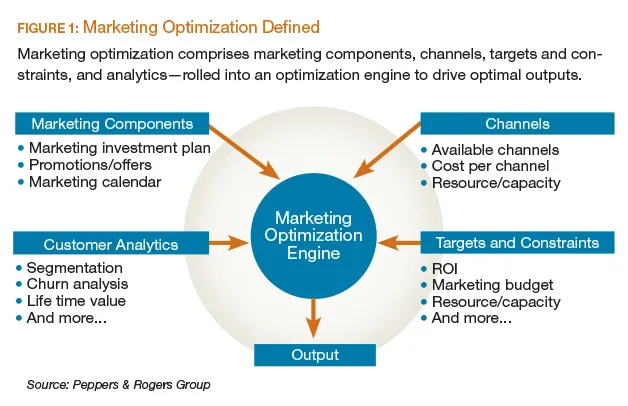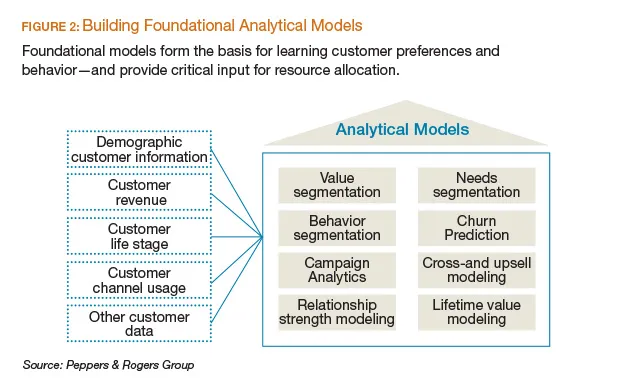As a customer, you don’t want to receive calls or direct mail that offer things you don’t need or might need two years from now. You only want companies to contact you when you need their product or service—with the right offer. Our customers expect nothing less from us. As marketers it is our job to meet those expectations.
On a daily basis we face the challenge of deciding how to manage our relationship with our customers while spending our budget to satisfy their needs and working to achieve the highest return on our investment. We are required to sell more while spending less doing it. And we need to achieve this without losing long-term customer equity in the process.
As if we didn’t have enough challenges, financial crises, toughening investor scrutiny, evolving channel preferences, generational shifts, and accelerating technology changes are prompting business leaders to hold their marketing teams accountable for sharper performance and results. Consequently, it has become imperative for marketing leaders to focus their attention on how they can best get their money’s worth; that is, improve their return on marketing investment (ROMI).
Marketing optimization is one approach marketers can use to build better customer relationships and improve their results. Simply put, marketing optimization aims to optimize an organization’s customer touch strategy, as well as to increase customer equity and return on marketing investments. Ultimately, it’s about targeting the right customers at the right time with the right offer via the right channel. Marketing optimization helps to maximize the value of each customer, and it can deliver better outcomes at every interaction by using a deep understanding of customer needs, behaviors, and value to determine the appropriate action and communication for each customer or customer group.
Increasing ROMI through marketing optimization—in other words, maximizing the value created by each individual customer interaction—requires delicately balancing five sometimes competing areas:
- Business drivers: There are many reasons to contact customers, whether to spur purchase behavior, refer, build engagement, and the like. Additionally, drivers change over time.
- Resource, channel, and other constraints: Marketing provides opportunities, but often there are resource constraints, channel limitations, and other obstacles that need to be considered while making decisions.
- Contact policies: Different organizations have different policies outlining such issues as contact frequency, opt-in procedures, privacy, and the like.
- Response propensities: How likely is a specific customer or customer group to respond to a certain message or offer?
- Lifetime value effects: Every interaction is an opportunity to build or destroy customer value. An email campaign, for example, may prompt one customer to buy and refer, but it may cause another to opt out.
Marketing optimization enables two important things: first, allocating marketing resources across multiple channels, business constraints, and marketing scenarios to target the right customer with the right product through the right channel at the right time, all while maximizing ROI; second, finding the right customer/offer/channel combinations increase the overall return while satisfying unique goals and constraints.
Marketing optimization should include four main inputs: marketing components, channels, targets and constraints, and analytics (see Figure 1). Marketing components encompass such areas as an investment plan, promotions, and a marketing calendar. Channel elements consist of not only available channels, but also the cost per channel and the available resources and capacity to best utilize each channel. Targets and constraints include the expected ROI and the marketing budget, as well as available resource and capacity. Finally, customer analytics are composed of such analyses as segmentation, churn analysis, and lifetime value calculations.
Additionally, marketing optimization models should be designed to combine and balance the insight gained through customer analytics with a company’s goals and constraints. Essentially, foundational customer analytical models should be analyzed using existing marketing activities, channels, constraints, and goals to determine the optimized distribution of marketing budget for specific channels, customer groups, and offers.

Critical elements for launching a successful marketing optimization program
There are five essential elements within the marketing optimization process—data inputs, models, methodology, objectives, and revisions—that marketers can blend and modify to attain optimal results from their efforts, as well as to increase ROMI:
1. Assessing data quality and availability The first element in the marketing optimization process is data. Marketers must begin by determining what customer information they will use to arrive at the best outputs and results. This should include analyzing the availability and quality of customer and transactional data, assessing existing models, gathering insight, and evaluating analytical capabilities.
Of course, not all companies have the same level of data availability or quality, or analytical capabilities. It may be necessary to modify which marketing models to use and how best to create each model based on data availability.
2. Building foundational analytical models Based on customer demographic, transactional, and channel data availability and considering a firm’s analytical capabilities and objectives, marketers should revise their existing models to develop relevant analytical models. Foundational analytical models include value, behavior, or needs segmentation, churn prediction, campaign analytics, lifetime value, and up/cross-sell modeling (see Figure 2). These models form the basis for learning customer preferences and behavior, and they provide critical input for resource allocation and for the optimization process.
Customer segmentation, for instance, brings customer value, needs, and behavior together to understand customers both qualitatively and quantitatively. Churn prediction makes it possible to understand main reasons behind customer churn and develop an early warning system to prevent customer attrition. Campaign analytics allows for the effective management of costs and profits related to campaigns by analyzing customer touches and responses. Up- and cross-sell modeling evaluates potential of customers for additional products and services. Lifetime value modeling provides insight on customer value not only in the short term, but also throughout the lifetime of the customer.
It’s not necessary to build every possible model. Business goals and resource constraints can help marketers determine the right mix of models to build.

3. Selecting marketing optimization objectives Defining objectives are probably the most critical and strategic piece in the success of marketing optimization. In other words, it’s essential to define which strategic objectives to emphasize in each model. The three competing yet complementary objectives are: acquisition, growth, and retention. For each of these, marketers should try to identify the target groups and the desired outcomes in terms of specific metrics.
Sample targets for acquisition might be prospects and inactive customers; analysis could be response prediction and revenue projection. For growth, sample targets might be new/current customers; analysis could be response analysis and growth projection. In retention, sample targets might also be new/existing customers; analysis could be response, churn prediction, and revenue projection.
4. Developing a marketing optimization methodology The fourth step brings customer insight and company objectives and constraints together. This is where marketing optimization efforts blend acquisition, retention, and growth strategic analysis with campaign analytics to determine customer-offer matching.
The ultimate objective is to determine total number of touches per channel per specified period for each strategic objective, select the target groups for each offer, and determine the number of touches per specific customer. This requires using such campaign analytics as touch, response, and recency analyses. Touch analysis provides when and through which campaign channels customers were touched. Response analysis supplies response ratio per customer for each campaign channel based on number of touches, as well as the number of responses for each campaign channel. Recency analysis shows the time that has passed between each customer’s last touch and date of the analysis.
The results can help determine customers who were and were not touched recently, and prioritize customers to be touched based on their segments. Additionally, a marketing optimization model executed with these inputs helps marketers to manage such constraints such as budget, capacity limitations, and channel alignments.
Once the marketing optimization program is in place marketers need to create a campaign execution plan. The plan can be a yearly campaign calendar with prioritization and detailed scope. Marketers can improve their results by running sensitivity analyses to uncover the effects of different parameters on targets. It’s also essential to develop a detailed ROI analysis for each campaign on a periodic basis to track the impact of the program.
5. Continuously monitoring and revising Marketing optimization is not a one-and-done plan. It is an ongoing strategy that must be tracked and analyzed to make improvements over time, as well as to adjust to changing business and customer requirements.
The two main items here are monitoring and dynamic correction. Monitoring includes continuous tracking and review of response analysis, as well as creating a response model to identify high-return marketing investments. Dynamic correction include finding and acting on failed marketing activities. Actions may include making changes to improve results, or canceling an activity completely.
Using these five elements to guide the marketing optimization process, marketers will increase their return on investment and maximize the value of each customer—ultimately, increasing customer equity in both the short and long term.
















